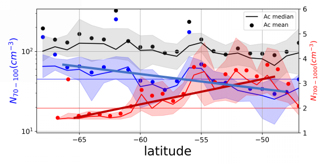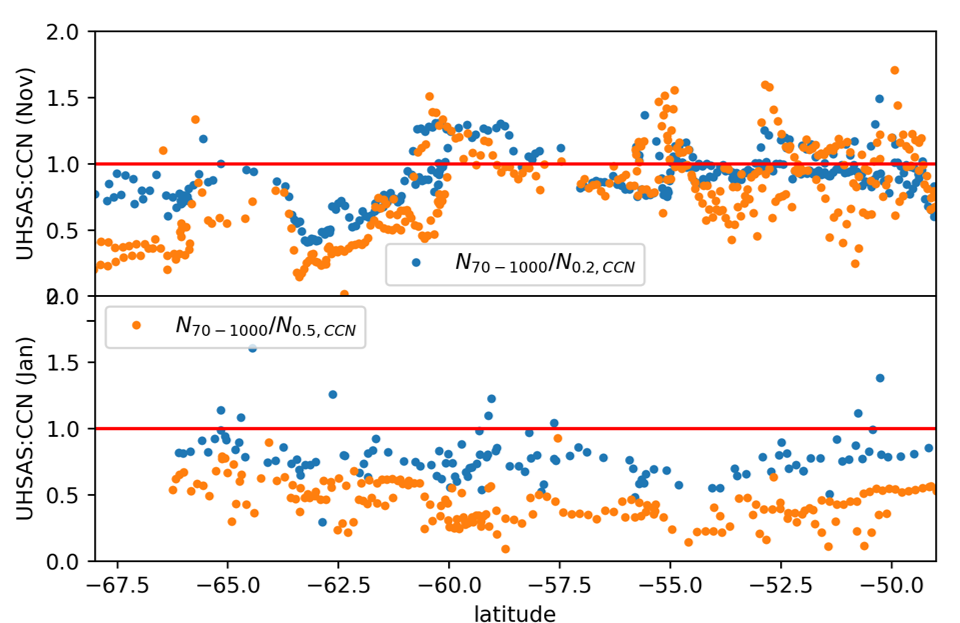62°S witnesses the transition of boundary-layer marine CCN and INPs
Submitter
McFarquhar, Greg — University of Oklahoma
Area of Research
Aerosol Properties
Journal Reference
Niu Q, G McFarquhar, R Marchand, A Theisen, S Cavallo, C Flynn, P DeMott, C McCluskey, R Humphries, and T Hill. 2024. "62°S Witnesses the Transition of Boundary Layer Marine Aerosol Pattern over the Southern Ocean (50°S–68°S, 63°E–150°E) during the Spring and Summer: Results from MARCUS (I)." Journal of Geophysical Research: Atmospheres, 129(9), e2023JD040396, 10.1029/2023JD040396.
Science

Figure 1. Latitudinal dependence of total aerosol concentration, and concentration between 70 and 100 nm (N70-100) and between 700 and 1000 num (N700-1000) for the whole MARCUS period. Points represent median and lines connect the means; shadows fill in ranges between first and third quartile. Image adapted from Niu et al. 2024.

Figure 2. Latitudinal dependence of aerosol number concentrations from ultra-high-sensitivity aerosol spectrometer (UHSAS) divided by CCN-100 concentration at supersaturation 0.2% in blue and 0.5% in yellow for month of November on top and January on bottom. Image supplied by Q. Niu.
Over the pristine Southern Ocean (50°S–68°S, 63°E–150°E), data acquired during the 2017–2018 Measurement of Aerosols, Radiation, and Clouds over the Pristine Southern Ocean (MARCUS) Experiment show that small aerosol particles suspended in the air, particularly those that can act as cloud condensation nuclei (CCN) and ice nucleating particles (INPs), strongly depend on season and latitude. The concentrations of both CCN and INPs vary more with season than latitude, and have greater concentrations over the summer South Southern Ocean (62°S–68°S).
Impact
The energy balance over the Southern Ocean (50°S–68°S, 63°E–150°E), particularly close to the ice-covered Antarctic where previous observations are scare, is heavily influenced by the aerosol particles suspended in the air through the absorption and scattering of radiation and through interactions with clouds. The concentrations of both CCN and INPs vary more with season than latitude, and are more plentiful over the summertime South Southern Ocean (62°S–68°S) than the North Southern Ocean. This has implications for understanding energy balance close to the Antarctic Peninsula.
Summary
The average North Southern Ocean CCN number concentration at 0.2% and 0.5% supersaturation were 28% and 49% less than that over the South Southern Ocean (SSO), which is caused by a decrease of small-accumulation-mode aerosols (with diameters (D) between 60 nm < D < 100 nm). This is related to the change of the size distribution and chemical composition of CCN-active particles with 60 nm < D < 1,000 nm, which is associated with varying CCN sources over different regions. The concentrations of ice nucleating particles (INPs) over the SSO were lower than those farther north, but there were greater fractions of biological INPs, particularly during January and February, over the SSO. The heating treatment and organic carbon digestion treatment of the INP suspensions prior to immersion freezing testing reveals that INPs originate from primarily organic and biological sources. The seasonal dependence of INPs over the NSO is stronger than over the SSO and could be associated with a seasonal shifting of biological proteins and organics from wind-wave interactions.
Keep up with the Atmospheric Observer
Updates on ARM news, events, and opportunities delivered to your inbox
ARM User Profile
ARM welcomes users from all institutions and nations. A free ARM user account is needed to access ARM data.


















